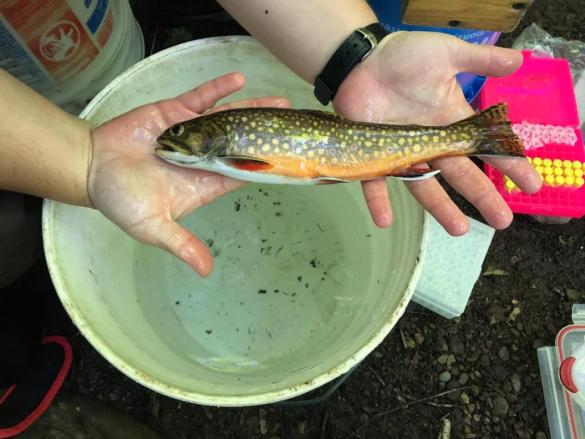September 2016 Edition | Volume 70, Issue 9
Published since 1946
A Race Against the Clock for Brook Trout Conservation
Are brook trout destined for extinction? That is a future that Shannon White, a Ph.D. student working with Dr. Tyler Wagner at the USGS Pennsylvania Cooperative Fish and Wildlife Research Unit at Penn State University, is working to avoid. One challenge is that the tools available to fisheries managers focus on solving problems within a watershed, but are not prepared to tackle future species-wide problems like climate change. The solution, White believes, is going back to basics and gaining a better understanding of brook trout ecology.
The brook trout is one of the valuable social and economic resources in coldwater streams throughout the Appalachian Mountains. As we transition into fall, the vitality of arguably the most beautiful freshwater species is brought center stage as fish prepare to engage in yearly spawning rituals. Vibrant orange colors are donned, miles of stream are traversed, and battles are fought all for the sake of producing the healthiest offspring. However, for many streams along the east coast, this fall could well be the last fanfare for brook trout. Within its native range on the east coast, fewer than half of historic populations remain, and surviving brook trout are swimming in troubled waters.
The brook trout is one of the valuable social and economic resources in coldwater streams throughout the Appalachian Mountains.

The use of telemetry also allows White to gather detailed data on other aspects of individual ecology, including cellular responses to stress. Since May she has been collecting gill filaments and blood samples from tagged fish to quantify the level at which certain genes are being expressed as stream temperatures rise. The genes she is interested in are like canaries in the coal mine ? they are only expressed when a fish is stressed, and before there are observable changes to fish behavior or mortality. By documenting expression of these genes, she can determine how individuals respond differently to thermal stress and how chronic stress may have caused some populations to evolve tolerance to higher temperatures.
When not in the field, White uses the more controlled conditions of the laboratory to investigate predictions on how fish personality may influence movement strategies. The concept of fish personality may seem bizarre, but it has been investigated formally for over 50 years and informally by anyone who has spent time gazing at their home aquaria. Some fish are bold ? readily engaging in fights and frantically investigating changes to their environment. Conversely, shy fish tend to be more cautious and reserved. In a recent publication, White found that personality may also influence learning ability and that bold fish were less capable of solving spatial tasks. White predicts that the inability to readily form spatial maps may lead bold fish to move when faced with environmental change and shy fish to stay and use spatial cues to solve the new environment. She hopes to test this prediction in the field soon.
White?s research focus reflects a mutual interest among the Pennsylvania Fish and Boat Commission, U.S. Fish and Wildlife Service, U.S. Geological Survey, and several university research scientists to not only improve fisheries management, but also gain a better understanding of why there is significant variation in natural populations. Fish living in the same stream can vary widely in their genetic, behavioral, and physiological attributes. However, the reason and cause of this variation is not well understood. White hopes that teasing this apart will help identify certain traits that may be particularly successful in future environments. For example, if there is a gene that increases tolerance to heat, then conservation of that gene might be a management focus.
To understand individual variation, White uses a combination of field and laboratory studies to measure some traditional, and some not-so-traditional, aspects of fish ecology. In the field, she is in the midst of a multi-season telemetry study to determine why some brook trout seem to move great distances, while others stick close to home. Movement behavior is particularly interesting because it is an ecological catch-22. By moving, fish can escape bad habitat and maintain connectivity to neighboring populations. However, moving is dangerous, as it increases the risk of predation and takes calories away from growth and reproduction. Long- and short-term population survival is therefore maximized if there is a mixture of both risky ?movers? and cautious ?stayers.? White has tagged over 160 brook trout, and hopes to find the genetic and environmental factors that influence individual movement patterns.
While White?s research focuses on brook trout, few species will be unaffected by climate change. She hopes that her results will not only improve trout management, but highlight the need to incorporate individual ecology into species conservation.
Learn more about brook trout and follow White?s research.
The ONB features articles from Cooperative Fish and Wildlife Research Units across the country. Working with key cooperators, including WMI, Units are leading exciting, new fish and wildlife research projects that we believe our readers will appreciate reading about. This article was written by Shannon White, Ph.D. working with Dr. Tyler Wagner, Assistant Unit Leader, USGS Pennsylvania Cooperative Fish and Wildlife Research Unit at Penn State University.